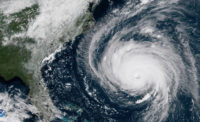Coastal cities are rapidly losing freeboard – the space between infrastructure and the ocean — as high-tide flooding is becoming a chronic rather than an infrequent problem.
“This is sea level rise,” said William Sweet, an oceanographer for the National Oceanic and Atmospheric Administration’s Center for Operational Oceanographic Products and Services. “It’s starting to impact infrastructure like storm water systems, fresh water systems, waste water systems as well as infrastructure at ground level, like roads and property. It’s not a year 2100 issue.”
High-tide flooding is affecting the functionality of septic systems in south Florida, flooding stores in Annapolis, Md., and salting farmland in Delaware and Maryland, he said.
Sweet is the lead author of a NOAA report on high tide flooding released June 10, which for the first time provides an outlook for high-tide flooding. In a conference call with reporters, he said the agency is releasing the forecast to help coastal cities prepare for the future.
Edgar Westerhof, in an unrelated conversation with ENR, says cities such as Charleston and Miami are taking the lead on addressing sea level rise.
“We will see solutions, there is no question about that,” says Westerhof, leader of U.S. Flood Risk and Resiliency. “The rising tides, extreme precipitation, nuisance flooding, climate stressors will drive change and they will drive change fast.”
The NOAA report says the frequency of high-tide flooding this year will be double what it was in 2000. The report identifies more than 40 locations where annual rates of high-tide flooding, also known as sunny-day flooding, are rapidly increasing.
Nationwide, coastal cities flooded an average of five days in 2018, tying the record of such days set in 2015.
By 2030 long-term projections show that number will increase to from 7 to 15 days. By 2050, the number rises to 25 to 75 days. The situation is worst in the Northeast, which experienced a median of 10 days of high-tide flooding in 2018. According to the report, this year, the Northeast could see a 140% increase in high-tide flooding, the Southeast Atlantic coast could experience a 190% increase and the Western Gulf of Mexico could have a 130% increase. This year and into 2020, an El Nino is exacerbating the number of high-tide flooding days.
In one example, Sweet says Baltimore was experiencing an average of two high-tide flood days in 2000. Last year, the city had 12.






Post a comment to this article
Report Abusive Comment